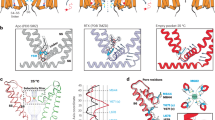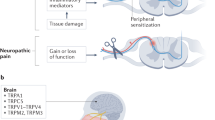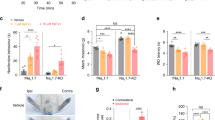Abstract
Since 1992, there has been growing evidence that the bioactive phospholipid lysophosphatidic acid (LPA), whose amounts are increased upon tissue injury, activates primary nociceptors resulting in neuropathic pain. The TRPV1 ion channel is expressed in primary afferent nociceptors and is activated by physical and chemical stimuli. Here we show that in control mice LPA produces acute pain-like behaviors, which are substantially reduced in Trpv1-null animals. Our data also demonstrate that LPA activates TRPV1 through a unique mechanism that is independent of G protein–coupled receptors, contrary to what has been widely shown for other ion channels, by directly interacting with the C terminus of the channel. We conclude that TRPV1 is a direct molecular target of the pain-producing molecule LPA and that this constitutes, to our knowledge, the first example of LPA binding directly to an ion channel to acutely regulate its function.
This is a preview of subscription content, access via your institution
Access options
Subscribe to this journal
Receive 12 print issues and online access
$259.00 per year
only $21.58 per issue
Buy this article
- Purchase on SpringerLink
- Instant access to full article PDF
Prices may be subject to local taxes which are calculated during checkout




Similar content being viewed by others
Change history
15 June 2012
In the version of this article initially published, the amount of LPA used in behavioral assays was incorrectly stated in the Methods section as 3 μg when it should have read 4.1 μg. Also, the details of preparation of LPA stock solutions were incomplete in the Methods section. The errors have been corrected in the HTML and PDF versions of the article.
References
Inoue, M. et al. Initiation of neuropathic pain requires lysophosphatidic acid receptor signaling. Nat. Med. 10, 712–718 (2004).
Okudaira, S., Yukiura, H. & Aoki, J. Biological roles of lysophosphatidic acid signaling through its production by autotaxin. Biochimie 92, 698–706 (2010).
Lin, M.E., Herr, D.R. & Chun, J. Lysophosphatidic acid (LPA) receptors: signaling properties and disease relevance. Prostaglandins Other Lipid Mediat. 91, 130–138 (2010).
Ma, L., Nagai, J. & Ueda, H. Microglial activation mediates de novo lysophosphatidic acid production in a model of neuropathic pain. J. Neurochem. 115, 643–653 (2010).
Chun, J., Hla, T., Lynch, K.R., Spiegel, S. & Moolenaar, W.H. International Union of Basic and Clinical Pharmacology. LXXVIII. Lysophospholipid receptor nomenclature. Pharmacol. Rev. 62, 579–587 (2010).
Roedding, A.S., Li, P.P. & Warsh, J.J. Characterization of the transient receptor potential channels mediating lysophosphatidic acid-stimulated calcium mobilization in B lymphoblasts. Life Sci. 80, 89–97 (2006).
Runnels, L.W., Yue, L. & Clapham, D.E. The TRPM7 channel is inactivated by PIP(2) hydrolysis. Nat. Cell Biol. 4, 329–336 (2002).
Jara-Oseguera, A., Simon, S.A. & Rosenbaum, T. TRPV1: on the road to pain relief. Curr. Mol. Pharmacol. 1, 255–269 (2008).
Yao, J., Liu, B. & Qin, F. Modular thermal sensors in temperature-gated transient receptor potential (TRP) channels. Proc. Natl. Acad. Sci. USA 108, 11109–11114 (2011).
Pan, H.L., Zhang, Y.Q. & Zhao, Z.Q. Involvement of lysophosphatidic acid in bone cancer pain by potentiation of TRPV1 via PKCɛ pathway in dorsal root ganglion neurons. Mol. Pain 6, 85 (2010).
Brauchi, S. et al. Dissection of the components for PIP2 activation and thermosensation in TRP channels. Proc. Natl. Acad. Sci. USA 104, 10246–10251 (2007).
Stein, A.T., Ufret-Vincenty, C.A., Hua, L., Santana, L.F. & Gordon, S.E. Phosphoinositide 3-kinase binds to TRPV1 and mediates NGF-stimulated TRPV1 trafficking to the plasma membrane. J. Gen. Physiol. 128, 509–522 (2006).
Ufret-Vincenty, C.A., Klein, R.M., Hua, L., Angueyra, J. & Gordon, S.E. Localization of the PIP2 sensor of TRPV1 ion channels. J. Biol. Chem. 286, 9688–9698 (2011).
Escalante-Alcalde, D., Sanchez-Sanchez, R. & Stewart, C.L. Generation of a conditional Ppap2b/Lpp3 null allele. Genesis 45, 465–469 (2007).
Caterina, M.J. et al. Impaired nociception and pain sensation in mice lacking the capsaicin receptor. Science 288, 306–313 (2000).
Jiang, G. et al. α-substituted phosphonate analogues of lysophosphatidic acid (LPA) selectively inhibit production and action of LPA. ChemMedChem 2, 679–690 (2007).
Oh, D.Y. et al. Identification of farnesyl pyrophosphate and N-arachidonylglycine as endogenous ligands for GPR92. J. Biol. Chem. 283, 21054–21064 (2008).
Alderton, F., Sambi, B., Tate, R., Pyne, N.J. & Pyne, S. Assessment of agonism at G-protein coupled receptors by phosphatidic acid and lysophosphatidic acid in human embryonic kidney 293 cells. Br. J. Pharmacol. 134, 6–9 (2001).
Zhang, H. et al. Dual activity lysophosphatidic acid receptor pan-antagonist/autotaxin inhibitor reduces breast cancer cell migration in vitro and causes tumor regression in vivo. Cancer Res. 69, 5441–5449 (2009).
Bang, S., Yoo, S., Yang, T.J., Cho, H. & Hwang, S.W. Farnesyl pyrophosphate is a novel pain-producing molecule via specific activation of TRPV3. J. Biol. Chem. 285, 19362–19371 (2010).
Cohen, A., Sagron, R., Somech, E., Segal-Hayoun, Y. & Zilberberg, N. Pain-associated signals, acidosis and lysophosphatidic acid, modulate the neuronal K(2P)2.1 channel. Mol. Cell. Neurosci. 40, 382–389 (2009).
Uehata, M. et al. Calcium sensitization of smooth muscle mediated by a Rho-associated protein kinase in hypertension. Nature 389, 990–994 (1997).
Bourinet, E., Soong, T.W., Stea, A. & Snutch, T.P. Determinants of the G protein-dependent opioid modulation of neuronal calcium channels. Proc. Natl. Acad. Sci. USA 93, 1486–1491 (1996).
Koch, W.J., Hawes, B.E., Inglese, J., Luttrell, L.M. & Lefkowitz, R.J. Cellular expression of the carboxyl terminus of a G protein-coupled receptor kinase attenuates Gβγ-mediated signaling. J. Biol. Chem. 269, 6193–6197 (1994).
Chaytor, A.T., Edwards, D.H., Bakker, L.M. & Griffith, T.M. Distinct hyperpolarizing and relaxant roles for gap junctions and endothelium-derived H2O2 in NO-independent relaxations of rabbit arteries. Proc. Natl. Acad. Sci. USA 100, 15212–15217 (2003).
Tang, L. et al. Antinociceptive pharmacology of N-(4-chlorobenzyl)-N′-(4-hydroxy-3-iodo-5-methoxybenzyl) thiourea, a high-affinity competitive antagonist of the transient receptor potential vanilloid 1 receptor. J. Pharmacol. Exp. Ther. 321, 791–798 (2007).
Cenni, V. et al. Regulation of novel protein kinase C ɛ by phosphorylation. Biochem. J. 363, 537–545 (2002).
Mintzer, E., Sargsyan, H. & Bittman, R. Lysophosphatidic acid and lipopolysaccharide bind to the PIP2-binding domain of gelsolin. Biochim. Biophys. Acta 1758, 85–89 (2006).
Kumar, N., Zhao, P., Tomar, A., Galea, C.A. & Khurana, S. Association of villin with phosphatidylinositol 4,5-bisphosphate regulates the actin cytoskeleton. J. Biol. Chem. 279, 3096–3110 (2004).
Klein, R.M., Ufret-Vincenty, C., Hua, L. & Gordon, S. Determinants of molecular specificity in phosphoinositide regulation. J. Biol. Chem. 283, 26208–26216 (2008).
Yao, J. & Qin, F. Interaction with phosphoinositides confers adaptation onto the TRPV1 pain receptor. PLoS Biol. 7, e46 (2009).
Prescott, E.D. & Julius, D. A modular PIP2 binding site as a determinant of capsaicin receptor sensitivity. Science 300, 1284–1288 (2003).
Tominaga, M. et al. The cloned capsaicin receptor integrates multiple pain-producing stimuli. Neuron 21, 531–543 (1998).
Inoue, M. et al. Lysophosphatidylcholine induces neuropathic pain through an action of autotaxin to generate lysophosphatidic acid. Neuroscience 152, 296–298 (2008).
Ueda, H. Peripheral mechanisms of neuropathic pain—involvement of lysophosphatidic acid receptor-mediated demyelination. Mol. Pain 4, 11 (2008).
Chemin, J. et al. Lysophosphatidic acid-operated K+ channels. J. Biol. Chem. 280, 4415–4421 (2005).
Kelly, J.J. Jr., Kyle, R.A., Miles, J.M. & Dyck, P.J. Osteosclerotic myeloma and peripheral neuropathy. Neurology 33, 202–210 (1983).
Schwei, M.J. et al. Neurochemical and cellular reorganization of the spinal cord in a murine model of bone cancer pain. J. Neurosci. 19, 10886–10897 (1999).
Marincsák, R. et al. Increased expression of TRPV1 in squamous cell carcinoma of the human tongue. Oral Dis. 15, 328–335 (2009).
Renbäck, K., Inoue, M., Yoshida, A., Nyberg, F. & Ueda, H. Vzg-1/lysophosphatidic acid-receptor involved in peripheral pain transmission. Brain Res. Mol. Brain Res. 75, 350–354 (2000).
García-Sanz, N. et al. A role of the transient receptor potential domain of vanilloid receptor I in channel gating. J. Neurosci. 27, 11641–11650 (2007).
McIntyre, T.M. et al. Identification of an intracellular receptor for lysophosphatidic acid (LPA): LPA is a transcellular PPARγ agonist. Proc. Natl. Acad. Sci. USA 100, 131–136 (2003).
Hama, K., Bandoh, K., Kakehi, Y., Aoki, J. & Arai, H. Lysophosphatidic acid (LPA) receptors are activated differentially by biological fluids: possible role of LPA-binding proteins in activation of LPA receptors. FEBS Lett. 523, 187–192 (2002).
Salazar, H. et al. A single N-terminal cysteine in TRPV1 determines activation by pungent compounds from onion and garlic. Nat. Neurosci. 11, 255–261 (2008).
Nishimasu, H. et al. Crystal structure of autotaxin and insight into GPCR activation by lipid mediators. Nat. Struct. Mol. Biol. 18, 205–212 (2011).
Hausmann, J. et al. Structural basis of substrate discrimination and integrin binding by autotaxin. Nat. Struct. Mol. Biol. 18, 198–204 (2011).
Karliner, J.S. Lysophospholipids and the cardiovascular system. Biochim. Biophys. Acta 1582, 216–221 (2002).
Sams, H.H., Dunnick, C.A., Smith, M.L. & King, L.E. Jr. Necrotic arachnidism. J. Am. Acad. Dermatol. 44, 561–573 (2001).
Caccin, P., Rigoni, M., Bisceglie, A., Rossetto, O. & Montecucco, C. Reversible skeletal neuromuscular paralysis induced by different lysophospholipids. FEBS Lett. 580, 6317–6321 (2006).
Rosenbaum, T. & Gordon, S.E. Dissecting intersubunit contacts in cyclic nucleotide-gated ion channels. Neuron 33, 703–713 (2002).
Acknowledgements
We thank D. Julius at University of California, San Francisco for providing the TRPV1 and TRPV2 cDNA, A. Patapoutian at the Scripps Research Institute for the TRPA1 cDNA, A. Toker at Harvard Medical School for PKCɛ dominant-negative and wild-type plasmids, J.A. García-Sáinz for his kind gift of BIM I and M. Calcagno for helpful discussion. We also thank L. Ongay, A. Escalante and F. Pérez at Instituto de Fisiología Celular, Universidad Nacional Autónoma de México (UNAM) for expert technical support and F. Sierra for expert help with DRG neuron culture. We are grateful to C.C. Durán and V.G. Soto for very valuable help with paw-withdrawal experiments. This work was supported by Dirección General de Asuntos del Personal Académico–Programa de Apoyo a Proyectos de Investigación e Innovación Tecnológica (DGAPA-PAPIIT) grant IN209209 and Instituto de Ciencia y Tecnología del Distrito Federal (ICYT-DF) grant PIFUTP09-262 to L.D.I., PAPIIT grants IN216009 and CONACyT 53777 to D.E.-A., and PAPIIT grants IN294111-3 and CONACyT CB-129474 and a grant from Fundación Miguel Alemán to T.R. This study was performed in partial fulfillment of the requirements for A.N.-P.'s doctoral degree in biomedical sciences at the UNAM.
Author information
Authors and Affiliations
Contributions
A.N.-P., G.P.-J. and A.J.-O. performed electrophysiological experiments. I.L. carried out all site-directed mutagenesis. S.M.-L. performed all animal matings, genotyping and biochemical assays. D.E.-A., L.D.I. and T.R. jointly conceived the study, performed recordings and analysis, and wrote the paper.
Corresponding authors
Ethics declarations
Competing interests
The authors declare no competing financial interests.
Supplementary information
Supplementary Text and Figures
Supplementary Methods and Supplementary Results (PDF 700 kb)
Rights and permissions
About this article
Cite this article
Nieto-Posadas, A., Picazo-Juárez, G., Llorente, I. et al. Lysophosphatidic acid directly activates TRPV1 through a C-terminal binding site. Nat Chem Biol 8, 78–85 (2012). https://doi.org/10.1038/nchembio.712
Received:
Accepted:
Published:
Issue Date:
DOI: https://doi.org/10.1038/nchembio.712



